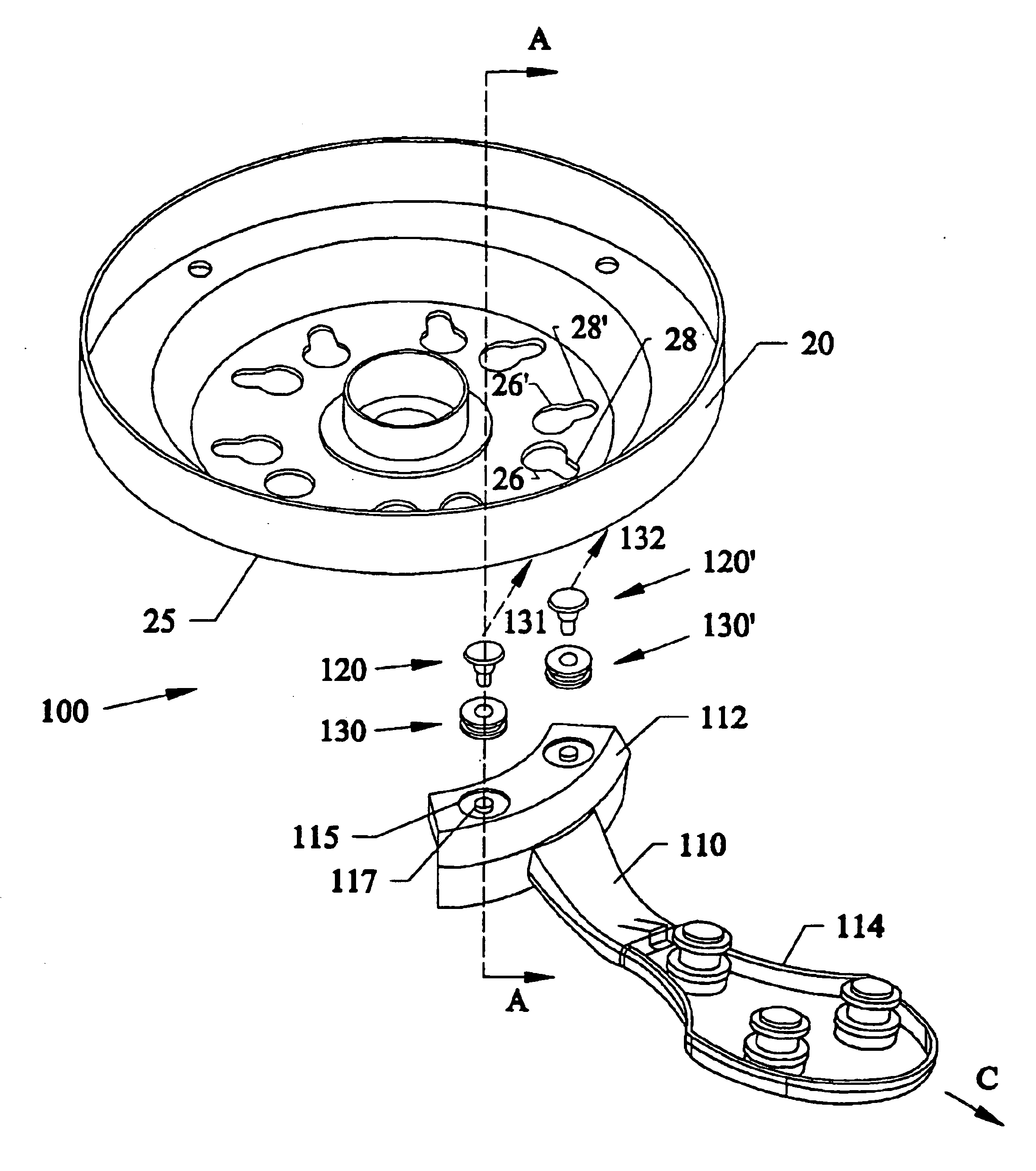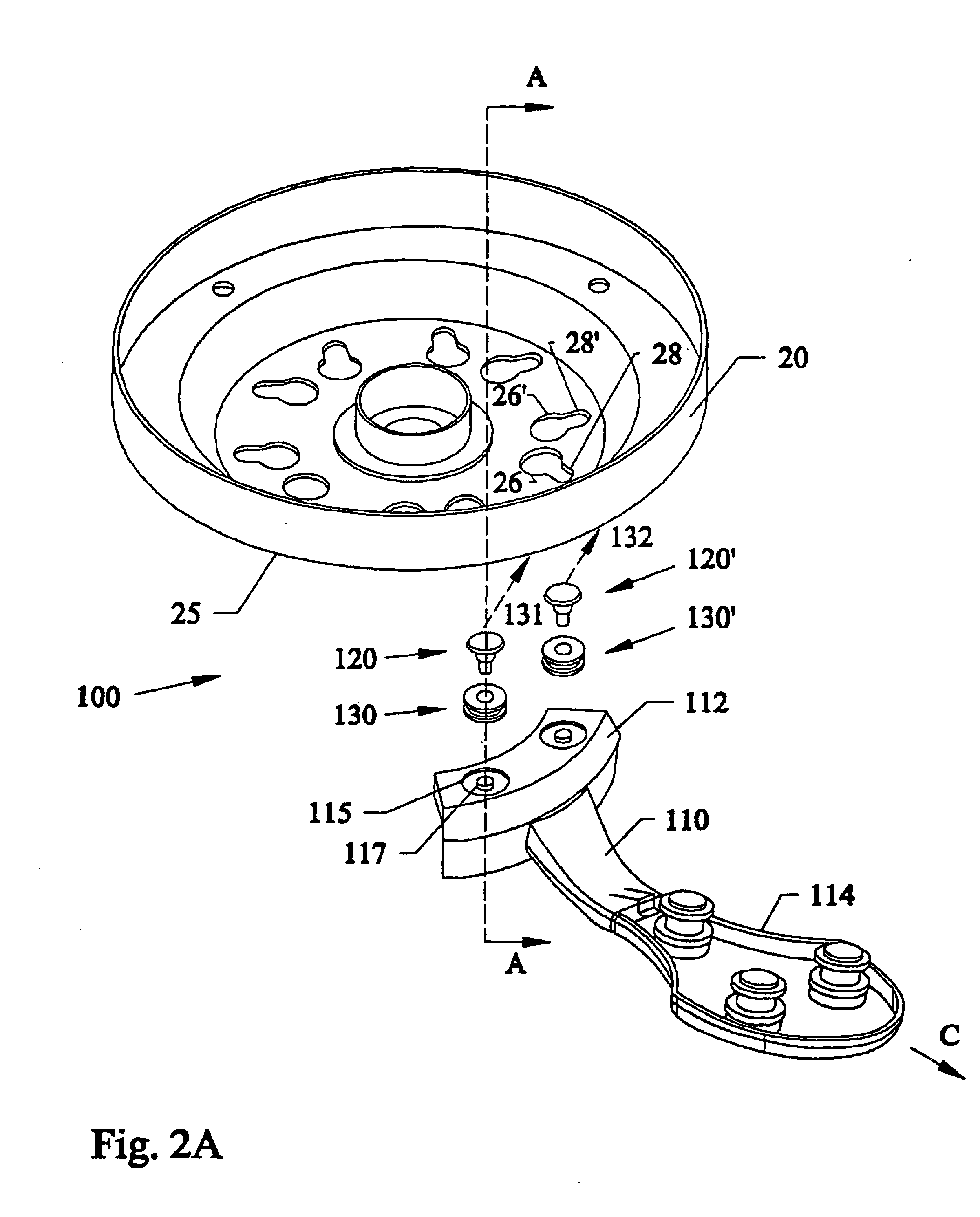Quick install blade arms for ceiling fans
a technology for ceiling fans and blade arms, which is applied in the direction of waterborne vessels, machines/engines, fastening devices, etc., can solve the problems of user injury, user loss of balance, and increased installation time and cost, and achieves the effect of easy and quick installation
- Summary
- Abstract
- Description
- Claims
- Application Information
AI Technical Summary
Benefits of technology
Problems solved by technology
Method used
Image
Examples
first embodiment
FIG. 2A is a perspective exploded view of a first embodiment 100 of the slip and lock fasteners 120, 120′, grommets 130, 130′, mounting arm 110, and rotor 20, 25 used for the subject invention. FIG. 2B is a side cross-sectional view of an assembled slide and lock fastener 120 and associated components of FIG. 2A along arrow A after being assembled and attached. FIG. 2C is an enlarged view of the slide and lock fastener of FIG. 2B with the protruding member 120 on the blade arm 110 and the slot 115 on the rotor 120, 125. FIG. 2D is a view of the flat-headed fastener screw 120 of FIG. 2C.
Referring to FIGS. 2A-2C, a mounting arm 110 has one end 114 connected to blade arms(not shown). End 114 can be connected to blade arms similar to that shown in FIG. 1. Alternatively, mounting arm 110 can be connected to detachable slide and lock blade fasteners such as those described in U.S. Ser. No. 09 / 200,607 filed Nov. 30, 1998 now U.S. Pat. No. 6,171,059 and U.S. application Ser. No. 08 / 851,501 ...
second embodiment
FIG. 3A is an exploded view of a second embodiment 200 of a quick install snapable mounting arm 210 for attaching to the rotor 20, 25 of a ceiling fan. FIG. 3B is a side cross-sectional view of the mounting arm 210 and rotor 20, 25 of FIG. 3A being attached together in the direction along arrow D. FIG. 3C is an enlarged view of the inwardly deformable snap fastener 220 and rotor 20, 25 of FIG. 3B. FIG. 3D is an enlarged view of the inwardly deformable snap fastener 220 of FIG. 3C.
Referring to FIGS. 3A-3D, mounting arm 210 can have one end 214 connected to ceiling fan blades similar to that shown in FIG. 1. Alternatively, blade connection end 214 can be attached to detachable slide and lock blade fasteners such as those described in U.S. Ser. No. 09 / 200,607 filed Nov. 30, 1998, now U.S. Pat. No. 6,171,059 and U.S. application Ser. No. 08 / 851,501 filed on May 5, 1997, now U.S. Pat. No. 6,010,306 both by the same assignees as that of the subject invention, which are both incorporated b...
third embodiment
FIG. 4A is an exploded view the third embodiment 300 of a removable quick install snap fastener 320 on the rotor 20, 25 of a ceiling fan that attaches to a mounting arm 310 and deformable gasket 330 therebetween. FIG. 4B is a side cross-sectional view of the mounting arm 310 and rotor 20, 25 of FIG. 4A being attached together along arrow G. FIG. 4C is a side view of the snap fastener of FIG. 4B.
Referring to FIGS. 4A-4C, mounting arm 310 has an end 314 that connects to ceiling fan blades similar to that shown in FIG. 1. Alternatively, blade connection end 314 can be attached to detachable slide and lock blade fasteners such as those described in U.S. Ser. No. 09 / 200,607 filed Nov. 30, 1998, now U.S. Pat. No. 6,171,059 and U.S. application Ser. No. 08 / 851,501 filed on May 5, 1997, now U.S. Pat. No. 6,010,306 both by the same assignees as that of the subject invention, which are both incorporated by reference. End 312 has a centrally located rectangular through-hole slot 315 and two up...
PUM
| Property | Measurement | Unit |
|---|---|---|
| centrifugal force | aaaaa | aaaaa |
| time | aaaaa | aaaaa |
Abstract
Description
Claims
Application Information
 Login to View More
Login to View More - R&D
- Intellectual Property
- Life Sciences
- Materials
- Tech Scout
- Unparalleled Data Quality
- Higher Quality Content
- 60% Fewer Hallucinations
Browse by: Latest US Patents, China's latest patents, Technical Efficacy Thesaurus, Application Domain, Technology Topic, Popular Technical Reports.
© 2025 PatSnap. All rights reserved.Legal|Privacy policy|Modern Slavery Act Transparency Statement|Sitemap|About US| Contact US: help@patsnap.com



